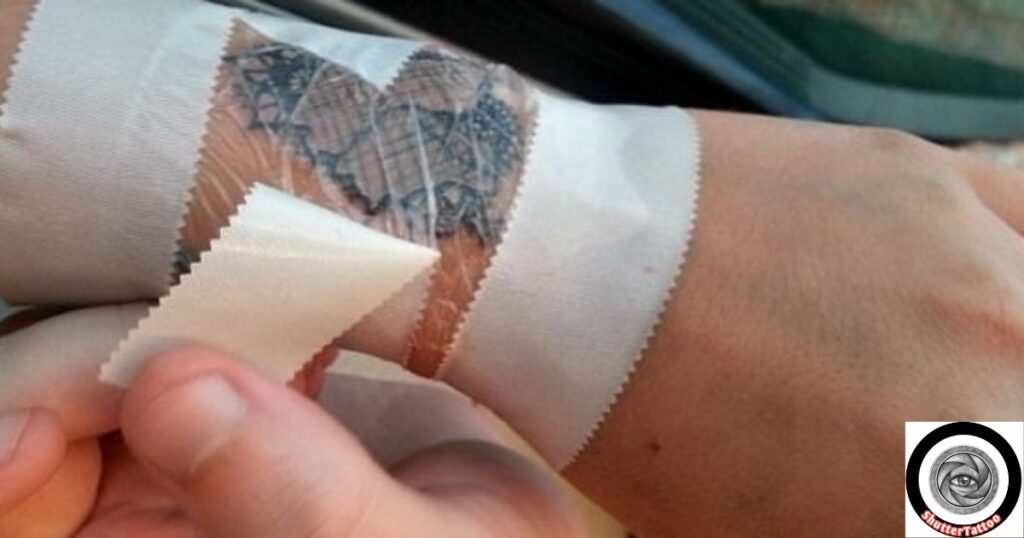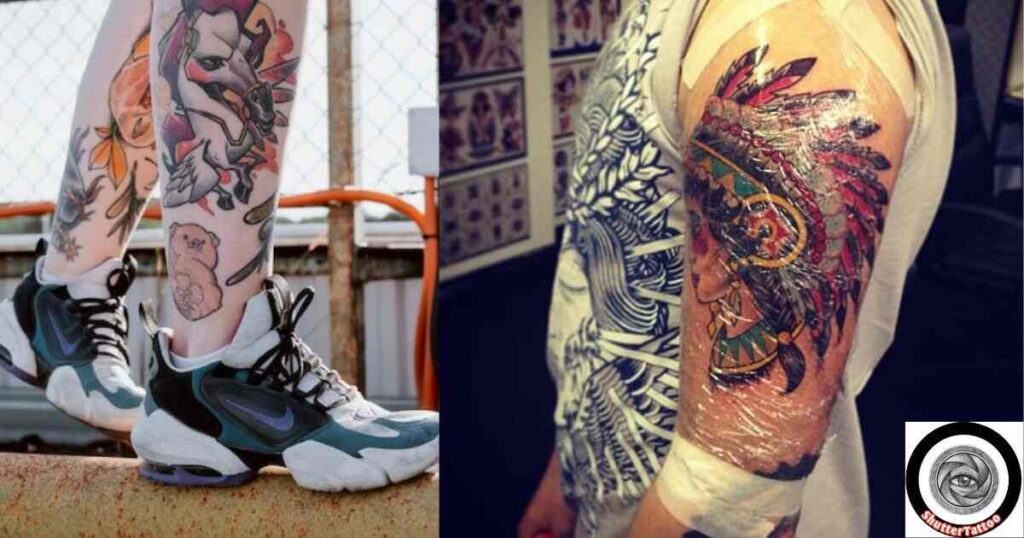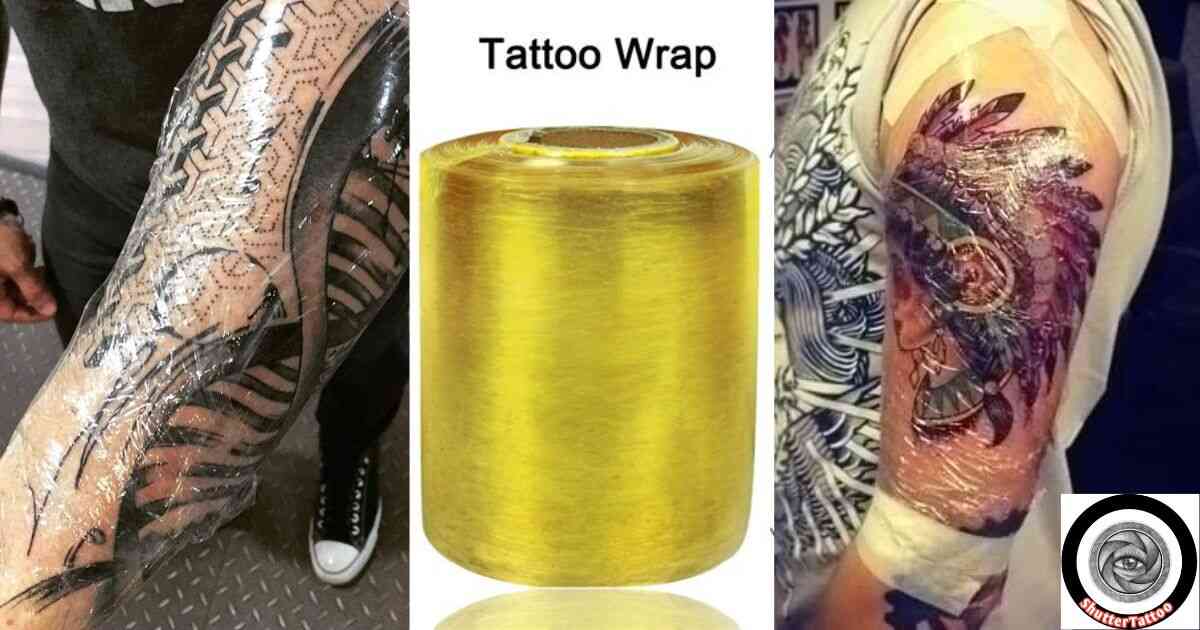Getting a new tattoo is an exciting experience, but proper aftercare is crucial to ensure your ink heals beautifully. One common method involves using cling film to protect the fresh tattoo. However, opinions on this practice vary among professionals. Some experts suggest that while cling film can shield the tattoo from infection, its non-breathable nature might impede the healing process.
In this article, we’ll explore essential aftercare practices, focusing on the role of cling wrap, to help you achieve optimal healing for your new tattoo.
The Role of Cling Wrap in Tattoo Healing

Cling wrap, commonly known as plastic wrap, plays a significant role in the initial stages of tattoo aftercare. Its primary functions include protecting the fresh tattoo from environmental contaminants, preventing friction and irritation, and maintaining moisture to aid healing.
Why Tattoo Artists Use Cling Wrap
Protection from Environmental Contaminants
After getting a tattoo, the skin is essentially an open wound, making it susceptible to bacteria and other harmful agents. Applying cling wrap creates a barrier that shields the tattoo from potential infections.
Prevention of Friction and Irritation
New tattoos are sensitive and can be easily irritated by clothing or external contact. Cling wrap minimizes friction, ensuring that the tattooed area remains undisturbed during the critical initial healing phase.
Maintaining Moisture to Aid Healing
Keeping the tattoo moist is essential for proper healing. Cling wrap helps retain the skin’s natural moisture, preventing it from drying out and forming excessive scabs, which can affect the tattoo’s appearance.
How Long Should You Keep Cling Wrap on a New Tattoo?
General Guidelines for Initial Wrapping
Tattoo artists often recommend keeping the initial cling wrap on for a few hours post-session. This period allows the skin to settle and reduces the risk of contamination.
Factors Influencing Wrapping Duration
The duration for which cling wrap should remain on a tattoo can vary based on factors such as the tattoo’s size, location, and individual skin type. It’s essential to follow the specific advice provided by your tattoo artist.
Expert Opinions and Recommendations
Some professionals advise rewrapping the tattoo with fresh cling film multiple times a day, especially during the first few days. Each time, it’s crucial to wash the tattoo gently with mild soap and water, pat it dry, and then apply a thin layer of aftercare ointment before rewrapping.
Potential Risks of Prolonged Cling Wrap Use

While cling wrap offers protective benefits, extended use can lead to complications such as skin maceration and an increased risk of infection.
Skin Maceration and Overhydration
Understanding Skin Maceration
Maceration occurs when the skin becomes overly saturated with moisture, leading to a soft, pale appearance. This condition can delay the healing process and make the skin more prone to damage.
Signs and Symptoms to Watch For
Indicators of maceration include excessive softness of the skin, a white or pale appearance, and increased sensitivity. If these symptoms arise, it’s advisable to consult with your tattoo artist or a healthcare professional.
Increased Risk of Infection
How Improper Wrapping Can Trap Bacteria
Using cling wrap for extended periods without changing it can create a warm, moist environment conducive to bacterial growth. This setting increases the risk of infection.
Preventative Measures to Ensure Safety
To minimize infection risks, always wash your hands thoroughly before touching the tattoo. Change the cling wrap regularly, ensuring the tattoo is cleaned and dried before reapplying. Avoid applying thick layers of ointment under the wrap, as this can further trap bacteria.
Best Practices for Using Cling Wrap in Tattoo Aftercare
Proper application of cling wrap is essential for effective tattoo aftercare. Begin by thoroughly washing your hands to prevent introducing bacteria to the fresh tattoo. Gently clean the tattooed area with lukewarm water and a mild, fragrance-free soap, then pat it dry with a clean towel.
Cut a piece of cling wrap large enough to cover the tattoo completely, ensuring it doesn’t touch any other skin areas. Apply the cling wrap smoothly over the tattoo, avoiding tightness to allow for natural skin movement. It’s crucial to maintain cleanliness during this process to prevent infection. After application, wash your hands again to ensure no contaminants are transferred.
Monitoring and Adjusting Aftercare Routine
After applying cling wrap, monitor the tattooed area for any signs of irritation or discomfort. It’s generally recommended to keep the cling wrap on for a few hours post-session to protect the new ink from bacteria and environmental contaminants.
If you experience excessive moisture buildup, discomfort, or notice any adverse reactions, it’s advisable to remove the cling wrap, clean the area, and allow it to air dry before reapplying. Adjust your aftercare routine based on your skin’s response and consult your tattoo artist if you have concerns.
Alternatives to Cling Wrap for Tattoo Protection
While cling wrap is commonly used, there are alternative products designed specifically for tattoo aftercare that may offer enhanced benefits.
Specialized Tattoo Films and Bandages
Products like Saniderm and Dermalize are specialized tattoo films designed to protect the tattooed area during the healing process. These films are breathable, allowing oxygen to reach the skin while keeping out bacteria and other contaminants. They also help in retaining the skin’s natural moisture, promoting faster healing.
Unlike traditional cling wrap, these products are designed to be left on for several days, reducing the need for frequent changes. However, it’s important to follow the manufacturer’s instructions and consult with your tattoo artist to determine if these products are suitable for your specific tattoo.
Natural Healing Methods
Some individuals prefer allowing their tattoos to heal without any coverings, a method known as dry healing. This approach involves keeping the tattoo exposed to air, relying on the body’s natural healing processes. The benefits of dry healing include reduced risk of trapping bacteria and the avoidance of potential skin reactions to adhesives.
However, this method requires diligent aftercare, including regular cleaning and moisturizing, and may not be suitable for everyone. It’s essential to weigh the pros and cons and consult with your tattoo artist to determine the best approach for your tattoo.
Read This Blog: Exploring the Cleveland Tattoo Convention: A Comprehensive Guide
Common Myths and Misconceptions About Cling Wrap in Tattoo Aftercare
When it comes to tattoo aftercare, several myths about cling wrap persist. One common misconception is that keeping a tattoo wrapped in cling film for extended periods accelerates healing. In reality, prolonged use can create a warm, moist environment conducive to bacterial growth, potentially leading to infection.
Another myth suggests that excessive moisture speeds up healing. While it’s important to keep the tattoo moisturized, overhydration can cause skin maceration, delaying the healing process.
Debunking Popular Beliefs
Addressing the myth of “the longer, the better”
Some believe that keeping a tattoo wrapped in cling film for days enhances healing. However, experts advise against prolonged wrapping, as it can trap bacteria and moisture, increasing infection risk.
Clarifying misconceptions about moisture and healing
While moisturizing is crucial, overhydration can impede healing. It’s essential to find a balance, applying a thin layer of ointment and allowing the skin to breathe.
Also Read This Blog: The Complete Guide to Baddie Women’s Feminine Spine Tattoos: Elegance Meets Empowerment
Expert Tips for Optimal Tattoo Healing
Professional tattoo artists emphasize the importance of following a structured aftercare routine. This includes gentle cleansing, appropriate moisturizing, and avoiding tight or restrictive coverings. They also recommend monitoring the tattoo for signs of infection and consulting a healthcare professional if concerns arise.
Advice from Professional Tattoo Artists
Personal experiences and recommendations
Many artists suggest using specialized tattoo films or breathable bandages instead of cling wrap. These alternatives provide protection while allowing the skin to breathe, promoting faster healing.
Common pitfalls to avoid during aftercare
Avoid scratching, picking scabs, or exposing the tattoo to excessive moisture. These actions can disrupt the healing process and affect the final appearance of the tattoo.
Incorporating Cling Wrap Use into Your Aftercare Routine
Balancing protection with exposure
If using cling wrap, limit its application to the initial hours after getting the tattoo. After that, switch to breathable bandages or let the tattoo air dry to promote healing.
Tailoring aftercare to individual needs
Each person’s skin reacts differently. Pay attention to how your skin responds and adjust your aftercare routine accordingly. Consult your tattoo artist for personalized advice.
FAQ
How long should I keep cling wrap on my new tattoo?
It’s generally recommended to keep the tattoo wrapped for 1 to 3 days, depending on the size and your artist’s advice.
Can I sleep with cling wrap on my tattoo?
It’s best to avoid sleeping with cling wrap on your tattoo to prevent moisture buildup and potential irritation.
Is it necessary to use cling wrap for tattoo aftercare?
While some artists recommend it, others suggest alternatives like specialized tattoo films. Always follow your artist’s guidance.
How often should I change the cling wrap on my tattoo?
Change the cling wrap at least three times a day and before bedtime to keep the tattoo clean and free from bacteria.
Can I use scented cling wrap on my tattoo?
It’s advisable to use unscented, standard cling wrap to avoid irritation and allergic reactions.
Conclusion
Proper aftercare is crucial for your tattoo’s healing process. While cling wrap can offer initial protection, it’s essential to follow your tattoo artist’s advice and monitor your skin’s response.
Remember, each person’s skin heals differently, so adjust your aftercare routine as needed. By staying informed and attentive, you can ensure your tattoo heals beautifully and remains vibrant for years to come.

